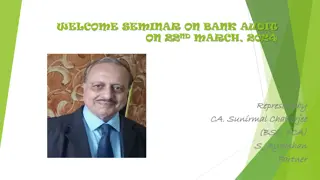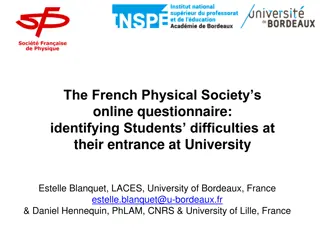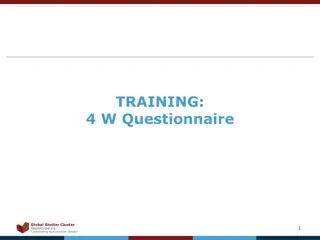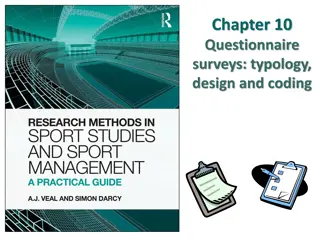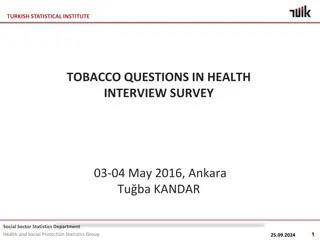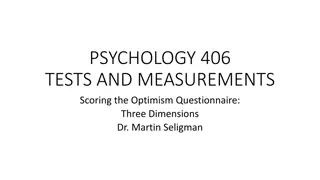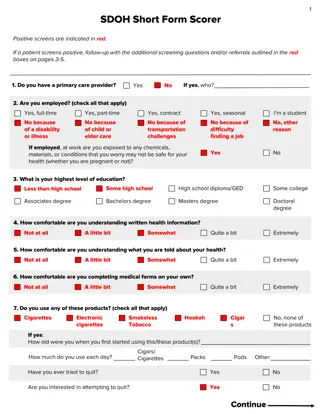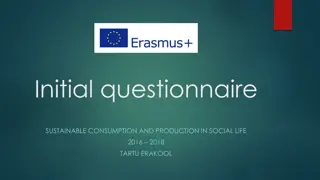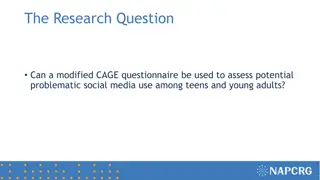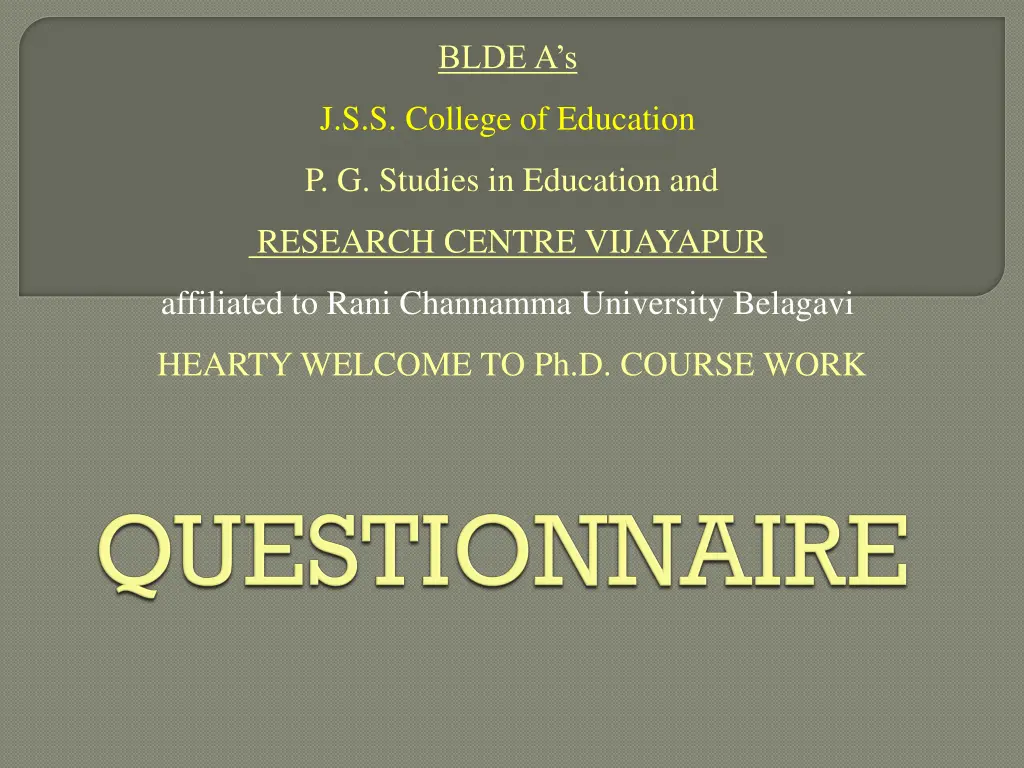
Mastering Questionnaire Design for Effective Research: A Comprehensive Guide
Explore the art of crafting effective questionnaires for research purposes. Learn about different types of questions, structuring and wording techniques, do's and don'ts, and guidelines for optimal questionnaire design. Enhance your understanding to ensure high response rates and valuable data collection.
Download Presentation

Please find below an Image/Link to download the presentation.
The content on the website is provided AS IS for your information and personal use only. It may not be sold, licensed, or shared on other websites without obtaining consent from the author. If you encounter any issues during the download, it is possible that the publisher has removed the file from their server.
You are allowed to download the files provided on this website for personal or commercial use, subject to the condition that they are used lawfully. All files are the property of their respective owners.
The content on the website is provided AS IS for your information and personal use only. It may not be sold, licensed, or shared on other websites without obtaining consent from the author.
E N D
Presentation Transcript
BLDE As J.S.S. College of Education P. G. Studies in Education and RESEARCH CENTRE VIJAYAPUR affiliated to Rani Channamma University Belagavi HEARTY WELCOME TO Ph.D. COURSE WORK
In general, this aims to provide a surface-level appreciation of one of the most-widely used research instrument, which is the Questionnaire. Specifically, this report wishes to impart the following so that the following aims will be achieved: To become familiar with the general Questionnaire types To compare and contrast open and closed Questions To point out how to word and structure Questions To identify the do s and don'ts in writing Questions To determine the proper length and ordering of Questions To know the process involved in piloting the Questionnaire To assure obtaining a high level of response To brush up with guidelines for Questionnaire design
Goode and Hatt: Questionnaire refers to a device for securing answers to a series of Questions by using a form which the respondent fills in himself. Barr et al: Questionnaire is a systematic compilation of Questions that are administered to a sample of population from which information is desired.
Seeks only that data which can not be obtained from the resources like Books, Reports and Records. It is as short as possible ,only long enough to get the essential data. Long questionnaires are frequently thrown away into the waste paper basket. It is at the same time as much comprehensive as necessary so, that it does not leave out any relevant and crucial information. It should be attractive in appearance, neatly arranged and clearly duplicated or printed. The questions are objective with no clues, hints or suggestions, as to the responses desired.
Each Question deals with a single Idea and is worded in simple and clear manner, as possible and provide an opportunity for easy, accurate and unambiguous response. Questions should be prepared in psychological order proceeding from general to more specific responses. This order helps the respondent to organise his own thinking so that his answers to be logical and objective. Descriptive adjectives and adverbs that have no agreed upon meanings are avoided. Exa: Words like Frequently, Occasionally, Rarely etc. Double negatives are also avoided. Exa: Don t you disapprove of forced discipline
Double barelled Questions or putting two Questions in one Question are also avoided. Exa: What is your main subject? Do you teach any other subject also apart from that? Leading questions are carefully avoided. Directions should be clear and complete. Important Terms are clarified. The Question should carry adequate number of Alternatives. It is to tabulate, summarise, and interpret
. Close-ended Questionnaires Usually utilized to generate statistics for quantitative research Follows a set format which makes the collation and analysis way easier Open ended Questionnaires Generally used for qualitative research Not a checklist; there are no boxes to tick Data analysis is more complex because there are not standard answers Combination of both Usually follow the following sequence: a series of close-ended questions, scales to rank, concluded by open-ended questions
Open Questions Closed Questions Tend to be slower Harder to record Difficult to code No predefined response New issues can be raised Respondents can speak their mind Some questions may be skipped All possible responses before designing a closed-ended questionnaire Quicker to administer Easier to record Easy to code Predefined responses No new issues can be raised Only best matches to actual opinion More likely to be answered fully A section for other opinions or other responses to cater to longer responses
Preparation: The Research Investigator thinks of various items to be covered in the Questionnaire; arrangement of these items in relation to one another and taking into consideration Questions prepared and used in other similar studies. Constructing the First Draft: The Research Investigator formulates a number of Questions, Direct/ Indirect, Closed/Open ended questions Self Evaluation: The Research Investigator thinks about Relevance, Symmetry, Clarity in language External Evaluation: The first draft is given to One or Two Expert Colleagues for scrutiny and suggestions for changes.
Revision: On the basis of suggestions received, some Questions are eliminated , some are modified and some new Questions may be added. Pre Test or Pilot Study: It is undertaken to check the stability of the Questionnaire as a whole. Revision: The minor and major changes may be made on the basis of experience gained in Pre-Testing. Second Pre Testing: The revised Questionnaire is then subjected to a second test and amended, if necessary. Preparing Final Draft: After editing, checking the spellings, space for Responses, Pre-Coding, the Final Draft is prepared.
Best: The lazy man s way of gathering information. - The unfavorable reaction among the respondents is intensified, when the Questionnaire is too long, the subject trivial in importance , the Question items vaguely worded, and the form poorly organised. As a result of this, a small proportion of mailed Questionnaires are returned and therefore, the data obtained are of low validity.


